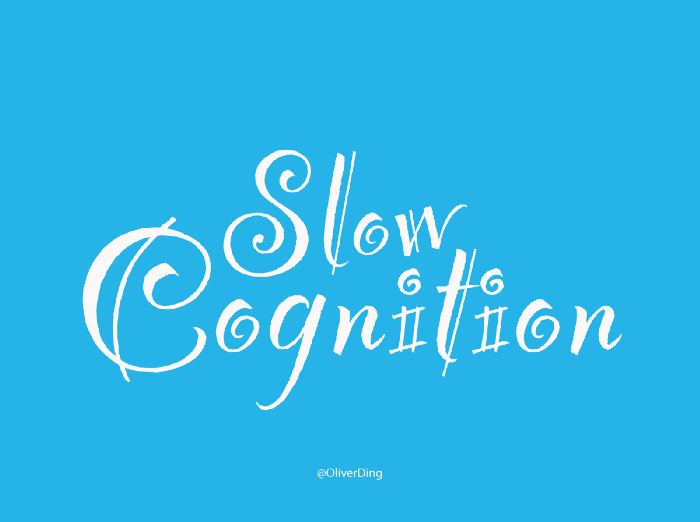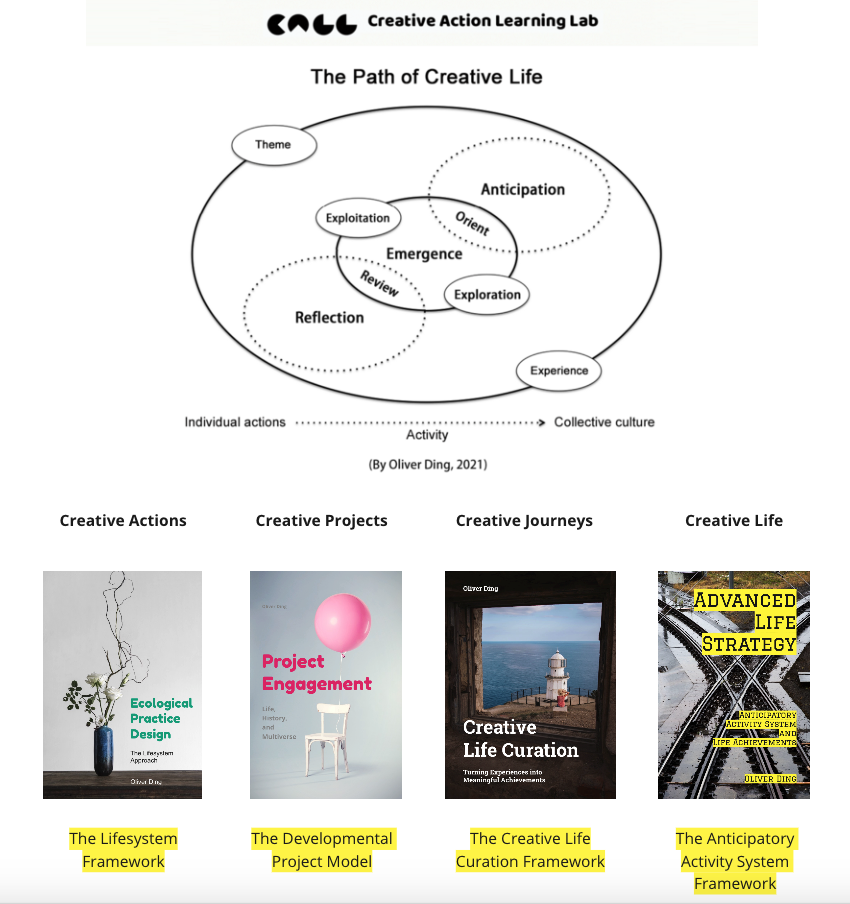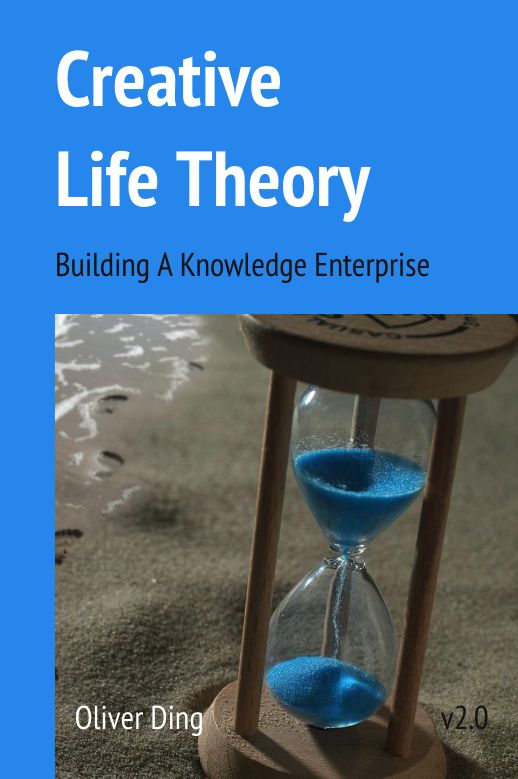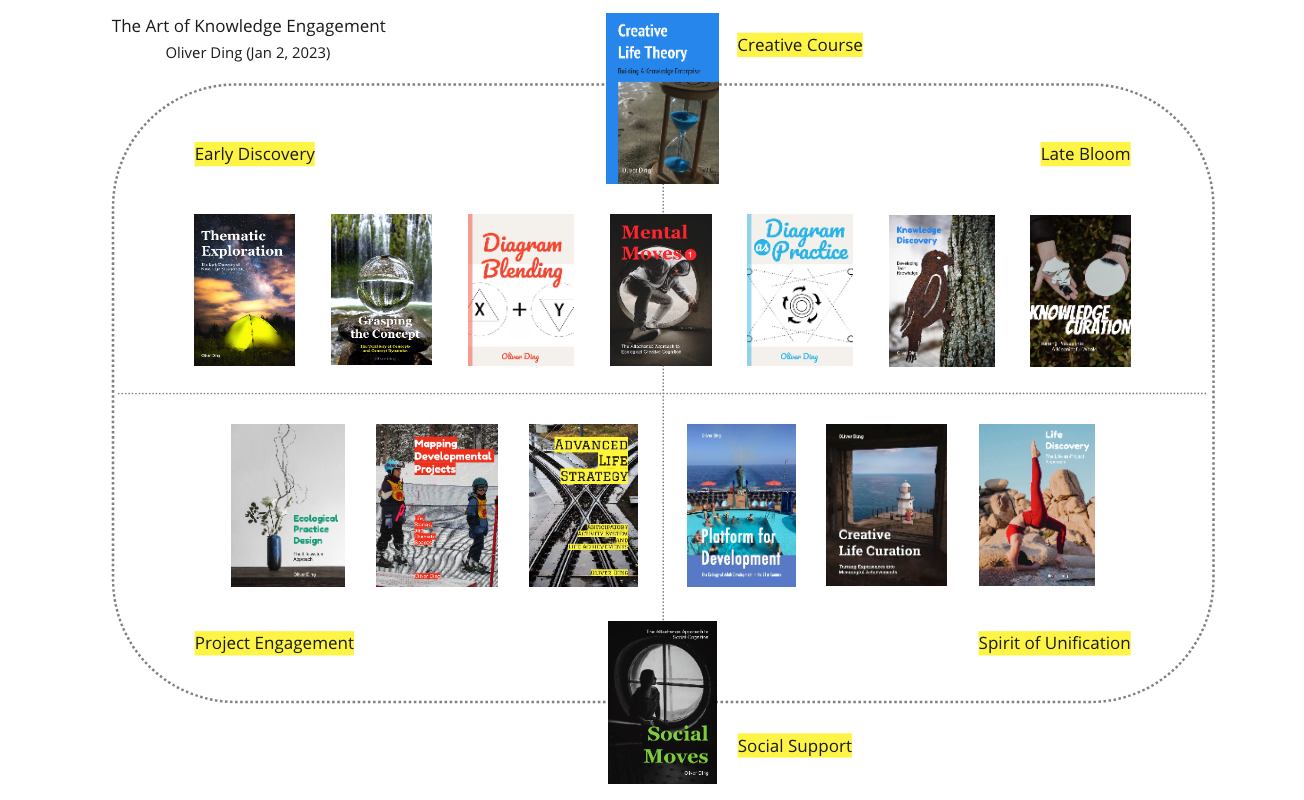The Slow Cognition Project and related methods

On April 26, 2021, I sent an email to a friend of mine and introduced my book The ECHO Way which reflects on my journey of writing three books in six months. I coined a new term called Slow Cognition to describe my favorite methods such as Howard E. Gruber’s evolving systems approach to creative work.
In Jan 2022, I designed the above picture and wrote a short post on Linkedin.
I used “A Theme for Creative Work Study in 2022” as the title of the short post. I spent 30 minutes designing a logo for Slow Cognition. This technique is called Objectification from the perspective of Project-oriented Activity Theory. Cognitive psychologists called it Cognitive Offloading. If an idea is very important to you, you could make a logo, design a picture, write a slogan, and print out these things.
It’s clear that I wanted to apply Howard E. Gruber’s evolving systems approach to conduct a research project.
The Slow Cognition Project (Phase I)
On May 19, 2022, I closed the Slow Cognition Project (Phase I) with a possible book titled Knowledge Discovery: Developing Tacit Knowlege with Thematic Space Canvas.

From Jan 2022 to May 2022, I worked on the Slow Cognition project that aims to explore the historical-cognitive approach and the long-term development of thoughts. I used two strategies to conduct the project:
- 1) I use my own real-life experience as data for the historical-cognitive analysis. From Jan 2022 to May 2022, I recorded ideas of my thoughts and wrote many articles on Medium. These records and articles represent the long-term development of my thoughts.
- 2) I use Donald Schön’s Reflective approach to reflect on the development of my thoughts within these months.
The primary project in these months is the Thematic Space project. Originally, I used the term “Thematic Space” to name an item for the Knowledge Curation model and canvas. Later, I developed a canvas for the concept of “Thematic Space”. This led to a series of canvases and a series of activities. You can find more details about the book here.
I use “Phase” to manage knowledge projects. Each phase is closed with a milestone and a knowledge product.
The Slow Cognition project (Phase II)
On May 31, 2022, I designed the picture below to highlight the focus of the Slow Cognition project (phase II).

My original intention behind the Slow Cognition project is to adopt Howard E. Gruber’s approach and method to studying creative work.
In the past months, I worked on both Howard E. Gruber’s approach and “Activity Theory” related approaches (especially Project-oriented Activity Theory and the “Anticipatory Activity System” framework). I realized that it’s possible to use the concept “Slow Cognition” to connect these two approaches.
This morning (May 30), I read Creative People at Work: Twelve Cognitive Case Studies (1989, Doris B. Wallace and Howard E. Gruber) and saw the first sentence of the Preface of the book. See the sentence below:
Our book is about how creative people do what they do.
In fact, “How…People do what they do” is the primary interest of Empirical Activity Theorists because they tend to watch how people do their work.
This sentence inspires me to write the new subtitle of the Slow Cognition project. Now I can connect these two approaches together.
While Phase I of the Slow Cognition project focuses on Instruments (the Thematic Space Canvas, etc), Phase II returns to its original focus: Methods (the Historical-cognitive approach, etc).
I also found a connection between the Slow Cognition project and the Anticipatory Activity System (AAS) project because some ideas of the AAS framework are related to the Slow Cognition method.
The "Slow Cognition" Method
From the perspective of Methods, I consider Phase II of the project as a dialogue between Howard E. Gruber’s Evolving Systems Approach and Activity Theory.
On May 30, 2022, I designed the diagram below.

The concept of “Mediated Action” refers to Lev Vygotsky’s idea about human psychological development. Vygotsky claimed that human action and psychological functions are mediated by tools which refer to technical tools that work on objects and psychological tools that mediate the mind and environment. This concept is the foundation of Activity Theory and CHAT (Cultural-historical activity theory) in general.
The Developmental Work Research (DWR) methodology is developed by Yrjö Engeström who is the author of Learning by Expanding: An Activity-Theoretical Approach to Developmental Research (1987). The DWR is based on the Activity System model and the model of Expansive Learning. You can find more details in Activity U (IV): The Engeström’s Triangle and the Power of Diagram.
The concept of “Networks of Enterprise” refers to Howard E. Gruber’s Evolving Systems Approach. Gruber’s approach uses “Task — Project — Enterprise — Network of Enterprise” as a structure to understand a creative person’s work. It is different from Activity Theory’s “Operation — Action — Activity” hierarchy.
- Task
- Project
- Enterprise
- Networks of Enterprise
The concept of “Networks of Enterprise” refers to the pattern of work in the life of a creative individual. Gruber said, “We use the term enterprise to stand for a group of related projects and activities broadly enough defined so that (1) the enterprise may continue when the creative person finds one path blocked but another open toward the same goal and (2) when success is achieved the enterprise does not come to an end but generates new tasks and projects that continue it.” (1989, p.11)
Since Gruber’s approach focuses on creative people and their work, we can use “Creative Work Study” to describe the application of the approach.
Though these two approaches use different structures to organize work, there is a connection between Gruber’s approach and Vygotsky’s perspective on creativity. According to Seana Moran and Vera John-Steiner (2000), “For Vygotsky, creativity not only transforms objective materials into creative products, it also transforms the creator…The more differentiated his personality becomes, the better able he may be to contribute and possibly transform his or her culture…”
For Gruber, the primary focus of his approach is the uniqueness of a creative person. Gruber succinctly summarizes the dialectic of creativity and transformation: “How can I express this peculiar idea that such an [creative] individual must be a self-generating system?…The system regulates the activity and the creative acts regenerate the system” (quoted in John-Steiner, 1997, p. 78).
The Slow Cognition Method echoes the lifespan perspective and follows Vygotsky and Gruber. According to Seana Moran and Vera John-Steiner (2000), “Vygotsky’s lifespan perspective parallels that of several contemporary Western researchers. Barron (1970) focused on the creative life more than the single creative act: what a creative genius may be remembered for historically is only a small subset of the many ideas he produces in his lifetime. Helson’s (1990, 1999) longitudinal study of women found that personality development and creative achievement interact dynamically. Wallace and Gruber (1989) and Gardner (1993) both take lifelong perspectives in their studies of creative individuals, and Csikszentmihalyi et al. (1993, 1996) have studied creative work at various stages of the lifespan.”
You can find more details in D as Diagramming: The Path of Creative Life.
The Slow Cognition Method is also inspired by the following ideas:
- The Historical-cognitive method (HC)
- The Cultural-historical method (CH)
- Experience Sampling Method (ESM)
- Project Engagement method (PE)
The Historical-cognitive method combines historical research and cognitive research together. This method is developed by Gruber.
- Also, Nancy J. Nersessian used “A Cognitive-Historical approach” to name her approach to Creativity in Conceptual Change.
The Cultural-historical method refers to Activity Theorists’ methodology in general. We should notice the newest development of Activity Theory is CHAT which stands for Cultural-historical activity theory.
The Experience Sampling Method (ESM) is also called the Daily diary method, or ecological momentary assessment (EMA). It asks participants to report on their thoughts, feelings, behaviors, and/or environment on multiple occasions over time. The experience sampling method was developed by Larson and Csikszentmihalyi.
The Project Engagement method is called Cultural Projection Analysis which is inspired by Activity Theory and Ecological Psychology. You can find more details in Activity U (X): Projecting, Projectivity, and Cultural Projection.
Creative Journey: The ECHO Way to Creative Work Study
On Oct 1, 2022, I closed the Slow Cognition project (phase II) with the following picture.

The major outcome of Phase II are the following three things:
1. The “Project — Journey” Structure for Creative Work Study
I developed the concept of “Creative Journey” as a new unit of analysis for studying creative life.
2. A new method of Mapping Creative Life with a set of tools
I designed a series of maps and developed a new method for mapping a creative person’s various creative projects from different units of analysis.
3. The ECHO Way (v3.0) model for Creative Cognition
I also developed the ECHO Way (v3.0) model for understanding Creative Cognition. The v3.0 emphasizes the ecological approach to cognition and applies it to study Creative Thematic Dialogue.
I will collect related articles and edit a new possible book. See more details in Creative Journey: The ECHO Way to Creative Work Study (Note).
Updated (Jan 11, 2024)
The Slow Cognition Project (phase II) was closed on Oct 1, 2022.
From Oct 2022 to Dec 2022, I worked on developing Creative Life Theory (v1.0) and edited four possible books (drafts).

In 2022, I developed a new structure of units of analysis:
1. Creative Actions
2. Creative Projects
3. Creative Journey
4. Creative Life
I also mentioned these four units of analysis in the following possible books:
1. Ecological Practice Design > Creative Actions
2. Project Engagement > Creative Projects
3. Creative Life Curation> Creative Journeys
4. Advanced Life Strategy > Creative Life
Each book also introduces a theoretical framework.
1. Ecological Practice Design > The Lifesystem Framework
2. Project Engagement > The Developmental Project Model
3. Creative Life Curation > The Creative Life Curation Framework
4. Advanced Life Strategy > The Anticipatory Activity System (AAS) Framework
You can find more details in Aspects of Creative Life (2022).
In 2023, I worked on developing Creative Life Theory (v2.0) and edited a book titled Creative Life Theory: Building A Knowledge Enterprise.

The Creative Life Theory (v2) which aims to develop a meta-framework to support the above multiple units of analysis. I also used the meta-framework to guide the Knowledge Engagement project.
The “Building A Knowledge Enterprise” activity is a sub-project of the Knowledge Engagement project. From May 2022 to Sept 2023, I worked on developing the concept of “Knowledge Center” which is a core idea of the “Building A Knowledge Enterprise” activity.

The new possible book aims to introduce the meta-framework of the Creative Life Theory (v2) and collect ideas about the “Building A Knowledge Enterprise” activity, such as “Knowledge Discovery”, “Knowledge Center”, “Creative Dialogue”, “Value Circle”, etc.
You can find more details in Creative Life Theory (v2, book, 2023).
On Jan 2, 2024, I selected 15 possible books about the theme of "Knowledge Engagement". See the diagram below.

You can find more details in The Art of Knowledge Engagement (15 Possible Books).
Case Studies
I am conducting case studies one by one for running the Slow Cognition project (Phase II) with the following tools:
- Milanote: digital whiteboard for creative curation
- Miro: digital whiteboard for designing diagrams and mapping ideas
- Coda: doc-centered collaborative platform
- Medium: publishing long articles
You can find more case studies in the list below.
- Significant Insights Analysis
- Modeling A Developmental Project
- Oliver Ding: The Activity U Project (2020–2022)
- The Deep Analogy Board — Activity Theory (April 22, 2022)
- Some Milestones of the AAS project
- Oliver Ding @ 2021 and Second-order Activity
- The Development of Ecological Practice Approach
- How did I develop Curativity Theory? (June 22, 2022)
- Mapping Thematic Spaces (July 14, 2022)
- Creative Attachance and Moving between Thematic Spaces (July 30, 2022)
- Life Discovery: Biography, Journey, Program (and a possible book, Part 1, Part 2, Part 3)
- The Development of the concept of “Thematic Spaces” (July 19, 2022)
- The Project Engagement Approach (v2, 2022)
- From TSI (Total Systems Intervention) to AAI (Activity Analysis Intervention)
- Significant Insight Analysis: The Notion of "Activity Analysis Intervention"
- Re-learning Activity Theory (June 27, 2022)
- Project Engagement (v2.1) as an Innovation Approach (August 2, 2022)
- The Development of Anticipatory Activity System (AAS) framework (August 21, 2021 - August 26, 2022)
- The Ecological Practice Approach in Feb 2020 (August 31, 2022)
- The Project Engagement Approach in Nov 2020 (Sept 1, 2022)
- Mapping Thematic Landscape (Curativity, 2019 - 2022) - Sept 5, 2022
- Mapping Thematic Journey (Engaging with Activity Theory, 2020 - 2022) - Sept 15, 2022
- The "Activity - Opportunity" Thematic Dialogue - Sept 22, 2022
- The Echoes of A Thematic Dialogue - Sept 26, 2022
- The "5A" Slow Cognition Model - Oct 12, 2022
- The Creative Life Curation Framework - Oct 20, 2022
- Three Paths of Creative Life and A Semiotic System - Oct 26, 2022
I also collect stories and examples for case studies.
- David K. Hurst: Discovering Complexity - Collected on June 17, 2022
- Walter Smith's meta-diagram - Collected on July 26, 2022
- Starting a Systems Thinking Consulting Firm: What have we learned, What are we learning! (Part 1, Part 2, Part 3) - Collected on August 12, 2022
- Modeling in Problem Solving (Part 0, Part 1, Part 2, Part 3, Part 4) by Jonathan Kahan - Collected on August 29, 2022
- Have A Look Around My Brain - Tobias Revall - Collected on Oct 27, 2022
- Dave Snowden: The Cynefin Framework (1999 - 2023) - Collected on Oct 27, 2023
If you want to share your stories of long-term thoughts, you can contact me on Linkedin.
